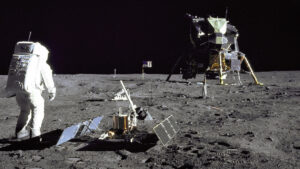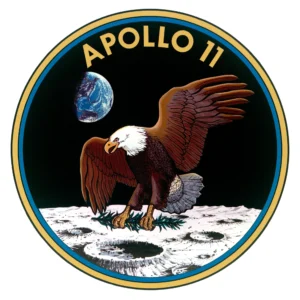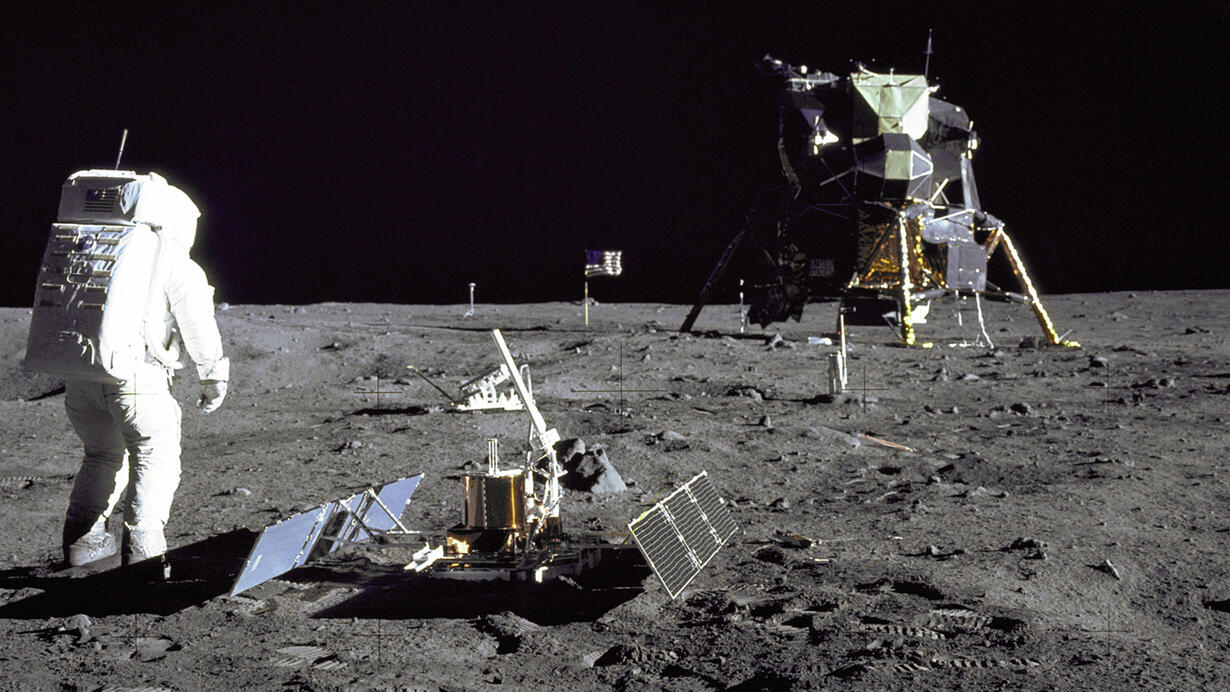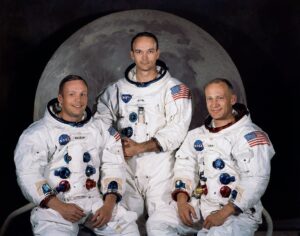
The Apollo 11 Mission: America’s Giant Leap for Mankind
On July 20, 1969, the entire world held its breath as three men, propelled by over 7.5 million pounds of thrust, embarked on a mission that had seemed impossible just a decade prior. The Apollo 11 mission, NASA’s crowning achievement and the climax of the United States’ intense “space race” against the Soviet Union, achieved what many thought was only the stuff of science fiction: humans landing on the moon. This historic event was not only a monumental achievement for the United States but a transformative moment for all of humanity.
The Cold War and the Space Race: The Origins of Apollo 11
To fully grasp the significance of Apollo 11, it’s essential to understand the context in which it occurred. In the aftermath of World War II, the United States and the Soviet Union found themselves locked in a Cold War, a geopolitical and ideological struggle for global influence. Among the various arenas of competition—politics, economics, military might—the “space race” became a key battleground.
The Soviet Union took an early lead when they launched Sputnik 1, the world’s first artificial satellite, on October 4, 1957. The event rattled the United States, sparking a sense of urgency and fear that the Soviets had gained a significant technological and military advantage. Four years later, in April 1961, Soviet cosmonaut Yuri Gagarin became the first human to journey into space, further solidifying the USSR’s dominance in space exploration.
In response, U.S. President John F. Kennedy, in a speech to Congress on May 25, 1961, issued a challenge that seemed incredibly audacious at the time: “I believe that this nation should commit itself to achieving the goal, before this decade is out, of landing a man on the Moon and returning him safely to the Earth.” Kennedy’s challenge set the stage for NASA to embark on one of the most ambitious and difficult scientific and engineering endeavors in human history.
The Apollo Program: A Journey of Trial and Triumph
The Apollo program was NASA’s direct response to Kennedy’s challenge. From the outset, the program was a staggering undertaking that required cutting-edge technology, rigorous scientific research, and meticulous planning. Each mission leading up to Apollo 11 played a crucial role in refining the techniques and technology needed to land a human on the moon. The program’s most tragic moment came with Apollo 1, when a cabin fire during a pre-flight test in 1967 claimed the lives of astronauts Gus Grissom, Ed White, and Roger B. Chaffee. Their deaths were a sobering reminder of the dangers of space exploration, but also a rallying point for NASA, pushing engineers to improve safety measures for future missions.
Apollo 8 marked a major milestone in December 1968 when, for the first time, humans left Earth’s orbit and circled the moon. The mission demonstrated that it was possible to reach the moon and return safely, and its iconic “Earthrise” photo, taken by astronaut William Anders, gave humanity a new perspective on its place in the universe. However, landing on the moon required even greater precision and risk, which would come to a head with Apollo 11.
The Crew: Neil Armstrong, Buzz Aldrin, and Michael Collins
Apollo 11’s success was due in no small part to the skill and bravery of its crew: Neil Armstrong, Buzz Aldrin, and Michael Collins. All three were experienced astronauts, with Armstrong serving as mission commander. Armstrong, a former Navy aviator and test pilot, had flown aboard Gemini 8 and was known for his calm demeanor under pressure. Aldrin, a West Point graduate and former fighter pilot, held a doctorate in astronautics from MIT and was the lunar module pilot. Michael Collins, the command module pilot, was tasked with staying in orbit around the moon, a critical role that required him to remain alone in lunar orbit while Armstrong and Aldrin descended to the moon’s surface.
The Launch and Journey to the Moon
Apollo 11 was launched on July 16, 1969, from Kennedy Space Center in Florida atop the Saturn V rocket, still the most powerful rocket ever built. The mission was watched by millions around the globe, with an audience of around 600 million people eventually tuning in for various parts of the mission. Saturn V had a flawless launch, sending the crew on their way to the moon. For the next four days, the crew traveled through the void of space, making minor course corrections as they prepared for the historic landing.
Upon reaching lunar orbit on July 19, the crew prepared for the most dangerous part of the mission: the descent to the moon’s surface. On July 20, Armstrong and Aldrin transferred into the lunar module, Eagle, while Collins remained in orbit aboard the command module, Columbia. The descent to the surface was filled with tension as Armstrong took manual control of the module to avoid large boulders and craters, while mission control in Houston anxiously monitored their fuel reserves, which were quickly running low.
Finally, after a harrowing descent, Eagle touched down in the Sea of Tranquility. Armstrong radioed back to Earth with the words: “Houston, Tranquility Base here. The Eagle has landed.” These words marked a turning point in human history—humanity had reached the surface of another celestial body.
The First Moonwalk: A Moment Frozen in Time
At 10:56 p.m. EDT, Neil Armstrong descended the ladder of the lunar module and became the first human to step foot on the moon. His words, “That’s one small step for [a] man, one giant leap for mankind,” resonated with the world and have since become one of the most famous quotes in history. Soon after, Aldrin joined Armstrong on the surface, and the two men spent approximately two hours conducting experiments, collecting moon rocks, and taking photographs.
One of the most iconic moments of the mission was the planting of the American flag on the lunar surface, symbolizing the success of American space exploration. However, the astronauts also left behind other items, including a plaque that read, “Here men from the planet Earth first set foot upon the Moon, July 1969 A.D. We came in peace for all mankind,” underscoring the mission’s broader significance beyond national pride.
The Return and Global Impact
After spending 21 hours on the lunar surface, Armstrong and Aldrin rejoined Collins aboard Columbia, and the crew began their journey back to Earth. On July 24, 1969, the crew safely splashed down in the Pacific Ocean, where they were recovered by the USS Hornet. The astronauts were immediately quarantined for 21 days as a precaution against possible lunar contamination—a safety measure that, while unnecessary, reflected the unknowns surrounding space exploration at the time.
Apollo 11’s return marked the successful completion of Kennedy’s goal, but it also symbolized much more. It united the world, with people from all nations—regardless of their political alliances—celebrating the achievement. The mission became a testament to human curiosity, determination, and the endless drive to push boundaries.
The Scientific and Cultural Legacy
The Apollo 11 mission had a profound and lasting impact on science, technology, and culture. The samples collected by Armstrong and Aldrin helped scientists better understand the moon’s geological history, and the mission proved that humanity could explore other worlds.
Culturally, the mission inspired generations to dream bigger and to pursue careers in science, engineering, and space exploration. It reshaped humanity’s understanding of its place in the universe, showing that we are capable of reaching beyond our own planet. The image of Earth seen from the moon, small and fragile against the vastness of space, helped fuel the growing environmental movement, reminding people of the importance of protecting our planet.
In the decades that followed, NASA continued the Apollo program, but none of the subsequent missions captured the world’s imagination in quite the same way as Apollo 11. The mission remains the crowning achievement of human space exploration and a symbol of what can be accomplished when nations unite behind a common goal.
Conclusion
The Apollo 11 mission was an extraordinary event in human history, representing both a technological triumph and a moment of profound cultural significance. It was a “giant leap” not just for America but for all mankind, opening the door to new possibilities in space exploration and demonstrating that the limits of human potential are far greater than we ever imagined. Fifty years later, the legacy of Apollo 11 endures, inspiring future generations to reach for the stars, just as Armstrong, Aldrin, and Collins did on that fateful day in 1969.

